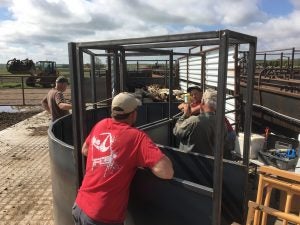Growing up, Sal Roseland’s dad always told him if he wanted to come back to the ranch, he’d better figure out a way to bring an extra $100,000 into the operation.
Roseland accepted that challenge, returning to the family’s 18,000-acre homestead in central South Dakota in 2002 with a business plan and the local bank’s approval to open R&R Pheasant Hunting.
“I just got done with school and graduated, had my business cards and brochures, web site started,” Roseland said. “I just had to talk my father and grandfather into taking over farming the land and carrying it into pheasant hunting, which was probably the toughest part of the whole business. In the farming community, change is always tough.”
Roseland is the fifth generation on the ranch. The Roseland Ranch was homesteaded in 1881 by Gabriel and Elizabeth Roseland, second generation immigrants from Norway. Today the family raises 1,000 head of Angus cow/calf pairs and grows wheat, corn, and soybeans on the 12,000 acres dedicated to the farming part of the business. The other 6,000 is reserved for Roseland’s hunting grounds.

R&R and the ranch continue to be a family affair — they have to be. During R&R’s hunting season from Sept. 1 to March 31, the Roselands average 600 hunters per year.
While Roseland runs the day-to-day and guides, his wife, Kelly, manages the cooking and cleaning. A client favorite, all of the dishes she cooks are from South Dakota-made products. His Grandma June, 85, still helps out, washing every single dish by hand. His mother, Deb, runs a side embroidery business for the lodge and also makes routine airport runs to Aberdeen, Pierre, and Gettysburg, South Dakota, to pick up guests.
Their clientele includes old family friends, fortune 500 executives, and outdoor enthusiasts from 13 foreign countries.
A habitat for 14,000 to 16,000 pheasants a year, R&R has to keep up land management and water drainage, plant trees, and maintain a set schedule with the South Dakota Games, Fish, and Parks to control their preserve’s pheasant population and when they should release birds.
R&R also provides all the hunting dogs, putting them through obedience training first before putting them on the pheasants themselves.
“We take a lot of pride in our dogs. A good dog will sell the hunt; a bad dog will ruin the hunt,” Roseland said.
In the off season, R&R’s lodges are open for family reunions, corporate retreats, and weddings.
Roseland built his operation strictly through the web, taking online classes and learning how to navigate free listings, Google, and social media. When Roseland started R&R, most of his competitors were well over the age of 50, and many were ex-farmers who had went broke farming, putting their land into the Conservation Reserve Program.
“I knew if I could get people here, once they were here, they would come back because of the experience and things that we were doing,” Roseland said.

The ranch has certainly built a solid reputation with hunters as well as sponsors. Browning Winchester provides R&R with 25 shotguns every year, and Winchester Ammunition provides the ammo.
In 2005 Cabela’s officially endorsed the hunting preserve and in 2007, they recognized R&R as one of the largest pheasant hunting operations in the world.
“There’s 5,000 places in South Dakota that you can go pheasant hunting. When you are trying to differentiate yourself from everyone else, why should people come to you? That’s something every lodge has to think about. You can’t copy what everyone else is doing,” Roseland said. “For us, it’s our family and our heritage.”
Roseland takes every single hunting group on a farm tour, from the original homestead to the current farm and cattle operation.
“A lot of the guys can’t believe this lifestyle of a family farming operation still exists. A lot of the 50 and 60-year-old guys grew up with some aspect of their life on a grandparent’s farm or an uncle’s farm, but it’s getting lost now- that connection to farming,” Roseland said. “The guys are very interested in our farming operation. A lot of the guys will hop in the combine with Dad or hop into the big 4-wheel drive or we let them drive the big tractors around the yard.”
A Class VI member in the South Dakota Agricultural and Rural Leadership program, Roseland learned the importance of being an ambassador for the state’s agriculture industry and showcasing the ranch with his guests.
The hunting operation has also been a great opportunity to bring extra income to the ranch, as well as to the state.
The South Dakota Department of Tourism estimates pheasant hunting generates $223 million in retail economic impact annually and an additional $111 million in salaries annually.
“The extra revenue that it brings in- especially year’s like this where the economy is down, where cattle prices are down, crop prices down a couple years — it is a great added income,” Roseland said.
For Roseland though, R&R has generated much more.
“The biggest thing for us is the experiences. I feel like I have the best job in the world,” Roseland said. “We are creating lifelong memories for people both young and old. For that, it is a very rewarding job.”
Did you like what you read? Sign up here in a heartbeat to get the best from AGDAILY.com!



